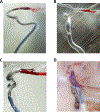Preclinical testing platforms for mechanical thrombectomy in stroke: a review on phantoms, in-vivo animal, and cadaveric models
- PMID: 33722966
- PMCID: PMC8364863
- DOI: 10.1136/neurintsurg-2020-017133
Preclinical testing platforms for mechanical thrombectomy in stroke: a review on phantoms, in-vivo animal, and cadaveric models
Abstract
Preclinical testing platforms have been instrumental in the research and development of thrombectomy devices. However, there is no single model which fully captures the complexity of cerebrovascular anatomy, physiology, and the dynamic artery-clot-device interaction. This article provides a critical review of phantoms, in-vivo animal, and human cadaveric models used for thrombectomy testing and provides insights into the strengths and limitations of each platform. Articles published in the past 10 years that reported thrombectomy testing platforms were identified. Characteristics of each test platform, such as intracranial anatomy, artery tortuosity, vessel friction, flow conditions, device-vessel interaction, and visualization, were captured and benchmarked against human cerebral vessels involved in large-vessel occlusion stroke. Thrombectomy phantoms have been constructed from silicone, direct 3D-printed polymers, and glass. These phantoms represent oversimplified patient-specific cerebrovascular geometry but enable adequate visualization of devices and clots under appropriate flow conditions. They do not realistically mimic the artery-clot interaction. For the animal models, arteries from swine, canines, and rabbits have been reported. These models can reasonably replicate the artery-clot-device interaction and have the unique value of evaluating the safety of thrombectomy devices. However, the vasculature geometries are substantially less complex and flow conditions are different from human cerebral arteries. Cadaveric models are the most accurate vascular representations but with limited access and challenges in reproducibility of testing conditions. Multiple test platforms should be likely used for comprehensive evaluation of thrombectomy devices. Interpretation of the testing results should take into consideration platform-specific limitations.
Keywords: blood flow; device; intervention; stroke; thrombectomy.
© Author(s) (or their employer(s)) 2021. No commercial re-use. See rights and permissions. Published by BMJ.
Conflict of interest statement
Competing interests: LS is the founder and stake-owner of Endovascular Engineering, Inc., which develops thrombectomy technologies. YL serves on this company’s Scientific Advisory Board.
Figures


Similar articles
-
Construction of a comprehensive endovascular test bed for research and device development in mechanical thrombectomy in stroke.J Neurosurg. 2020 Apr 3;134(3):1190-1197. doi: 10.3171/2020.1.JNS192732. Print 2021 Mar 1. J Neurosurg. 2020. PMID: 32244204
-
Human "live cadaver" neurovascular model for proximal and distal mechanical thrombectomy in stroke.J Neurointerv Surg. 2023 May;15(5):465-472. doi: 10.1136/neurintsurg-2022-018686. Epub 2022 Apr 13. J Neurointerv Surg. 2023. PMID: 35418449
-
A human brain test bed for research in large vessel occlusion stroke.J Neurosurg. 2021 Jan 22;135(4):1072-1080. doi: 10.3171/2020.7.JNS202278. Print 2021 Oct 1. J Neurosurg. 2021. PMID: 33482637
-
Preclinical modeling of mechanical thrombectomy.J Biomech. 2022 Jan;130:110894. doi: 10.1016/j.jbiomech.2021.110894. Epub 2021 Dec 8. J Biomech. 2022. PMID: 34915309 Review.
-
Direct Carotid Puncture for Emergent Thrombectomy: 2-Dimensional Operative Video.Oper Neurosurg. 2021 Jan 13;20(2):E126-E127. doi: 10.1093/ons/opaa379. Oper Neurosurg. 2021. PMID: 33438015 Review.
Cited by
-
Impact of Target Artery Size on the Performance of Aspiration Thrombectomy: Insights from a Swine Model with Real-Time Visualization.AJNR Am J Neuroradiol. 2024 Jun 7;45(6):727-730. doi: 10.3174/ajnr.A8198. AJNR Am J Neuroradiol. 2024. PMID: 38575321 Free PMC article.
-
A Review of the Advancements in the in-vitro Modelling of Acute Ischemic Stroke and Its Treatment.Front Med Technol. 2022 Jun 8;4:879074. doi: 10.3389/fmedt.2022.879074. eCollection 2022. Front Med Technol. 2022. PMID: 35756535 Free PMC article. Review.
-
A Thrombectomy Model Based on Ex Vivo Whole Human Brains.AJNR Am J Neuroradiol. 2021 Nov;42(11):1968-1972. doi: 10.3174/ajnr.A7291. Epub 2021 Sep 23. AJNR Am J Neuroradiol. 2021. PMID: 34556479 Free PMC article.
-
Arterial Collapse during Thrombectomy for Stroke: Clinical Evidence and Experimental Findings in Human Brains and In Vivo Models.AJNR Am J Neuroradiol. 2022 Feb;43(2):251-257. doi: 10.3174/ajnr.A7389. Epub 2022 Jan 13. AJNR Am J Neuroradiol. 2022. PMID: 35027348 Free PMC article.
-
Quantification of clot spatial heterogeneity and its impact on thrombectomy.J Neurointerv Surg. 2022 Dec;14(12):1248-1252. doi: 10.1136/neurintsurg-2021-018183. Epub 2021 Dec 15. J Neurointerv Surg. 2022. PMID: 34911736 Free PMC article.
References
-
- Zaidat OO, Castonguay AC, Linfante I, Gupta R, Martin CO, Holloway WE, MuellerKronast N, English JD, Dabus G, Malisch TW, et al.First pass effect: A new measure for stroke thrombectomy devices. Stroke. 2018;49:660–666. - PubMed
-
- Kleine JF, Wunderlich S, Zimmer C, Kaesmacher J. Time to redefine success? TICI 3 versus TICI 2b recanalization in middle cerebral artery occlusion treated with thrombectomy. J. Neurointerv. Surg 2017;9:117–121. - PubMed
-
- Mehra M, Henninger N, Hirsch JA, Chueh J, Wakhloo AK, Gounis MJ. Preclinical acute ischemic stroke modeling. J. Neurointerv. Surg 2012;4:307–313. - PubMed
-
- Herrmann AM, Meckel S, Gounis MJ, Kringe L, Motschall E, Mülling C, Boltze J. Large animals in neurointerventional research: A systematic review on models, techniques and their application in endovascular procedures for stroke, aneurysms and vascular malformations. J. Cereb. Blood Flow Metab 2019;39:375–394. - PMC - PubMed
Publication types
MeSH terms
Grants and funding
LinkOut - more resources
Full Text Sources
Other Literature Sources
Medical
Miscellaneous
